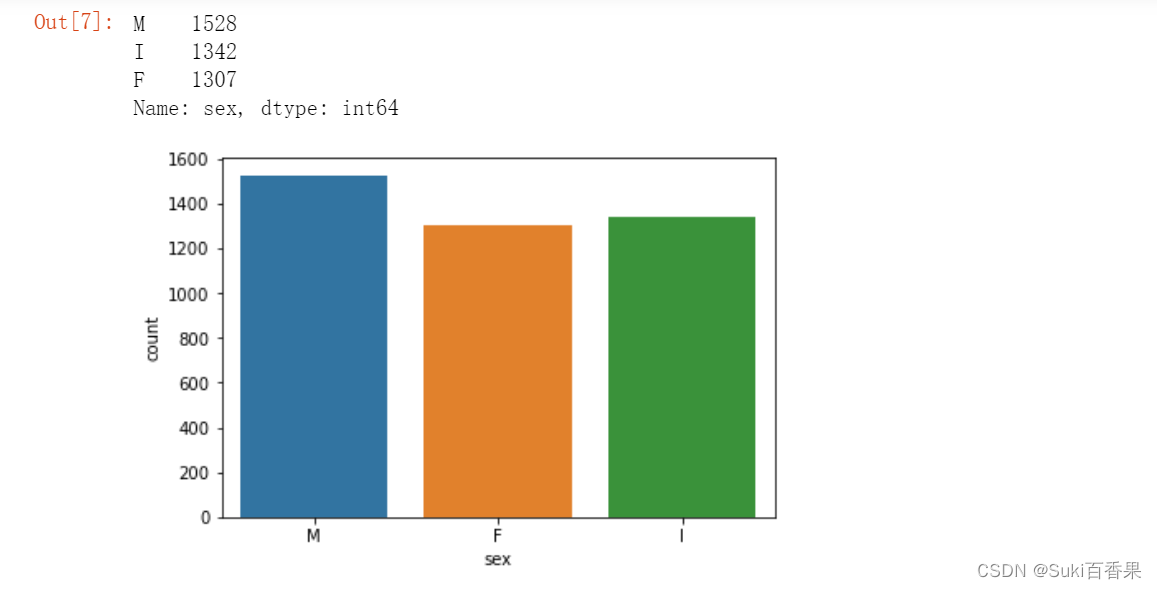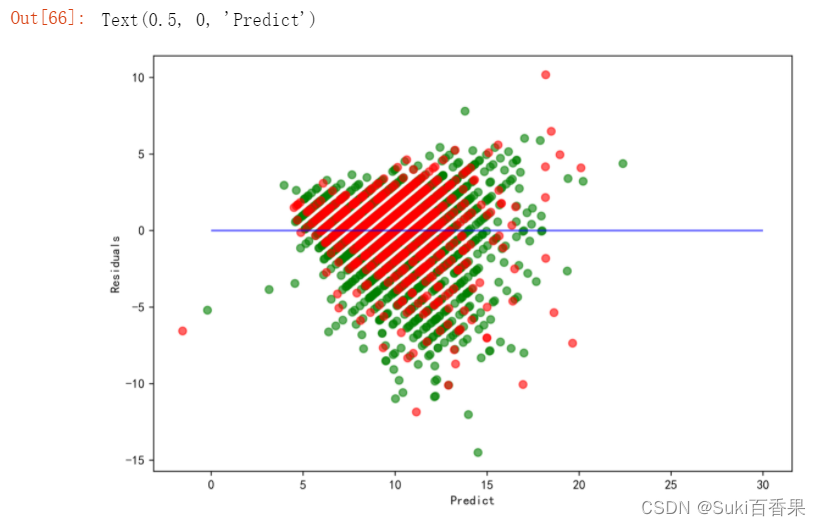目录
1.对sex特征进行OneHot编码,便于后续模型纳入哑变量
一、数据集探索性分析
import pandas as pdimport numpy as npimport seaborn as snsdata = pd.read_csv("abalone_dataset.csv")data.head()
#查看数据集中样本数量和特征数量data.shape#查看数据信息,检查是否有缺失值data.info()
data.describe()
数据集一共有4177个样本,每个样本有9个特征。其中rings为鲍鱼环数,加上1.5等于鲍鱼年龄,是预测变量。除了sex为离散特征,其余都为连续变量。
#观察sex列的取值分布情况import numpy as npimport matplotlib.pyplot as plt%matplotlib inlinesns.countplot(x='sex',data=data)data['sex'].value_counts()
对于连续特征,可以使用seaborn的distplot函数绘制直方图观察特征取值情况。我们将8个连续特征的直方图绘制在一个4行2列的子图布局中。
i=1plt.figure(figsize=(16,8))for col in data.columns[1:]: plt.subplot(4,2,i) i=i+1 sns.distplot(data[col])plt.tight_layout()
sns.pairplot()官网 seaborn.pairplot — seaborn 0.12.2 documentation
默认情况下,此函数将创建一个轴网格,这样数据中的每个数字变量将在单行的y轴和单列的x轴上共享。对角图的处理方式不同:绘制单变量分布图以显示每列数据的边际分布。也可以显示变量的子集或在行和列上绘制不同的变量。
#连续特征之间的散点图sns.pairplot(data,hue='sex')
* 1.第一行观察得出:length和diameter、height存在明显的线性关系
* 2.最后一行观察得出:rings与各个特征均存在正相关性,其中与height的线性关系最为直观
* 3.对角线观察得出:sex“I”在各个特征取值明显小于成年鲍鱼
#计算特征之间的相关系数矩阵corr_df = data.corr()corr_df
fig,ax =plt.subplots(figsize=(12,12))#绘制热力图ax = sns.heatmap(corr_df,linewidths=5, cmap='Greens', annot=True, xticklabels=corr_df.columns, yticklabels=corr_df.index)ax.xaxis.set_label_position('top')ax.xaxis.tick_top()
二、鲍鱼数据预处理
1.对sex特征进行OneHot编码,便于后续模型纳入哑变量
#类别变量--无先后之分,使用OneHot编码#使用Pandas的get_dummies函数对sex特征做OneHot编码处理sex_onehot =pd.get_dummies(data['sex'],prefix='sex')#prefix--前缀data[sex_onehot.columns] = sex_onehot#将set_onehot加入data中data.head()
2.添加取值为1的特征
#截距项data['ones']=1data.head()
3. 计算鲍鱼的真实年龄
data["age"] =data['rings']+1.5data.head()
4.筛选特征
多重共线性
*最小二乘的参数估计为如果变量之间存在较强的共线性,则$X^TX$近似奇异,对参数的估计变得不准确,造成过度拟合现象。
*解决办法:正则化、主成分回归、偏最小二乘回归所以sex_onehot的三列,线性相关,三列取两列选入x中
y=data['rings']#不使用sklearn(包含ones)features_with_ones=['length', 'diameter', 'height', 'whole weight', 'shucked weight', 'viscera weight', 'shell weight', 'sex_F', 'sex_I','ones' ]#使用sklearn(不包含ones)features_without_ones=['length', 'diameter', 'height', 'whole weight', 'shucked weight', 'viscera weight', 'shell weight', 'sex_F', 'sex_I']X=data[features_with_ones]
5. 将鲍鱼数据集划分为训练集和测试集
#80%为训练集,20%为测试集from sklearn.model_selection import train_test_splitX_train,X_test,y_train,y_test = train_test_split(X,y,test_size=0.2,random_state=111)
三、实现线性回归和岭回归
1. 使用Numpy使用线性回归
#判断xTx是否可逆,并计算得出w#解析解求线性回归系数def linear_regression(X,y): w = np.zeros_like(X.shape[1]) if np.linalg.det(X.T.dot(X))!=0: w = np.linalg.inv(X.T.dot(X)).dot(X.T).dot(y) return w#使用上述实现的线性回归模型在鲍鱼训练集上训练模型w1=linear_regression(X_train,y_train)w1 = pd.DataFrame(data=w1,index=X.columns,columns=['numpy_w'])w1.round(decimals=2)
所以, 求得的模型为
y=-1.12 * length + 10 * diameter + 20.74 * height + 9.61 * whole_weight - 20.05 * shucked_weight - 12.07 * viscera - weight + 6.55 * shell_weight + 0.01 * sex_F - 0.37 * sex_I + 3.70
2.使用Sklearn实现线性回归
from sklearn.linear_model import LinearRegressionlr = LinearRegression()lr.fit(x_train[features_without_ones],y_train)print(lr.coef_)
w_lr = []w_lr.extend(lr.coef_)w_lr.append(lr.intercept_)w1['lr_sklearn_w']=w_lrw1.round(decimals=2)
3.使用numpy实现岭回归
def ridge_regression(X,y,ridge_lambda): penalty_matrix = np.eye(X.shape[1]) penalty_matrix[X.shape[1] - 1][X.shape[1] - 1] = 0 w=np.linalg.inv(X.T.dot(X) + ridge_lambda*penalty_matrix).dot(X.T).dot(y) return w
#正则化系数设置为1w2 = ridge_regression(X_train,y_train,1.0)print(w2)
w1['numpy_ridge_w']=w2w1.round(decimals=2)
4. 利用sklearn实现岭回归
from sklearn.linear_model import Ridgeridge = Ridge(alpha=1.0)ridge.fit(X_train[features_without_ones],y_train)w_ridge = []w_ridge.extend(ridge.coef_)w_ridge.append(ridge.intercept_)w1["ridge_sklearn_w"] = w_ridgew1.round(decimals=2)
岭迹分析
alphas = np.logspace(-10,10,20)coef = pd.DataFrame()for alpha in alphas: ridge_clf = Ridge(alpha=alpha) ridge_clf.fit(X_train[features_without_ones],y_train) df = pd.DataFrame([ridge_clf.coef_],columns=X_train[features_without_ones].columns) df['alpha']=alpha coef = coef.append(df,ignore_index=True)coef.round(decimals=2)
import matplotlib.pyplot as plt%matplotlib inline#绘图#显示中文和正负号plt.rcParams['font.sans-serif']=['SimHei','Times New Roman']plt.rcParams['axes.unicode_minus']=Falseplt.rcParams['figure.dpi']=300#分辨率plt.figure(figsize=(9,6))coef['alpha']=coef['alpha']for feature in X_train.columns[:-1]: plt.plot('alpha',feature,data=coef)ax=plt.gca()ax.set_xscale('log')plt.legend(loc='upper right')plt.xlabel(r'$\alpha$',fontsize=15)plt.ylabel('系数',fontsize=15)
四、 使用LASSO构建鲍鱼年龄预测模型
LASSO的目标函数
随着𝜆增大,LASSO的特征系数逐个减小为0,可以做特征选择;而岭回归变量系数几乎趋近与0
from sklearn.linear_model import Lassolasso=Lasso(alpha=0.01)lasso.fit(X_train[features_without_ones],y_train)print(lasso.coef_)print(lasso.intercept_)
#LASSO的正则化渠道coef1 = pd.DataFrame()for alpha in np.linspace(0.0001,0.2,20): lasso_clf = Lasso(alpha=alpha) lasso_clf.fit(X_train[features_without_ones],y_train) df = pd.DataFrame([lasso_clf.coef_],columns=X_train[features_without_ones].columns) df['alpha']=alpha coef1 = coef1.append(df,ignore_index=True)coef1.head()plt.figure(figsize=(9,6),dpi=600)for feature in X_train.columns[:-1]: plt.plot('alpha',feature,data=coef1)plt.legend(loc='upper right')plt.xlabel(r'$\alpha$',fontsize=15)plt.ylabel('系数',fontsize=15)plt.show()
coef1
五、 鲍鱼年龄预测模型效果评估
1.计算MAE、MSE及R2系数
from sklearn.metrics import mean_squared_errorfrom sklearn.metrics import mean_absolute_errorfrom sklearn.metrics import r2_score#MAEy_test_pred_lr=lr.predict(X_test.iloc[:,:-1])print(round(mean_absolute_error(y_test,y_test_pred_lr),4))y_test_pred_ridge=ridge.predict(X_test[features_without_ones])print(round(mean_absolute_error(y_test,y_test_pred_ridge),4))y_test_pred_lasso=lasso.predict(X_test[features_without_ones])print(round(mean_absolute_error(y_test,y_test_pred_lasso),4))#MSEy_test_pred_lr=lr.predict(X_test.iloc[:,:-1])print(round(mean_absolute_error(y_test,y_test_pred_lr),4))y_test_pred_ridge=ridge.predict(X_test[features_without_ones])print(round(mean_absolute_error(y_test,y_test_pred_ridge),4))y_test_pred_lasso=lasso.predict(X_test[features_without_ones])print(round(mean_absolute_error(y_test,y_test_pred_lasso),4))
#R2系数print(round(r2_score(y_test,y_test_pred_lr),4))print(round(r2_score(y_test,y_test_pred_ridge),4))print(round(r2_score(y_test,y_test_pred_lasso),4))
2.残差图
plt.figure(figsize=(9,6),dpi=600)y_train_pred_ridge=ridge.predict(X_train[features_without_ones])plt.scatter(y_train_pred_ridge,y_train_pred_ridge - y_train,c='g',alpha=0.6)plt.scatter(y_test_pred_ridge,y_test_pred_ridge - y_test,c='r',alpha=0.6)plt.hlines(y=0,xmin=0,xmax=30,color='b',alpha=0.6)plt.ylabel('Residuals')plt.xlabel('Predict')
观察残差图,可以发现测试集的点(红色)与训练集的点(绿点)基本吻合。模型训练效果不错。
来源地址:https://blog.csdn.net/WSY_nian/article/details/129331568
































